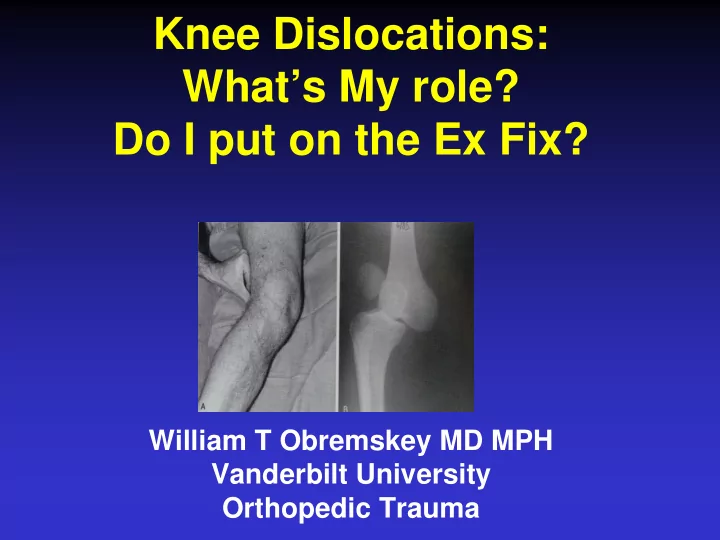

Knee Dislocations: What’s My role? Do I put on the Ex Fix? William T Obremskey MD MPH Vanderbilt University Orthopedic Trauma
Disclosures • Board SEFC • OTA EBQVS Chair • No Industry Conflicts
What’s My role? • Role – Reduce Joint – Assess Neuro/Vacular – Assist Vascular if needed – Release Compartments if needed – Stabilize - ?
Do I put on the Ex Fix? • It depends
OBJECTIVES • What knee injuries are likely to result in vascular injury? • What is appropriate evaluation? • When Ex Fix? • Irreducible KD?
JAAOS December 2015
Schenck Classification KD I Multiligamentous injury with involvement of ACL or PCL KD II Injury to ACL and PCL only (2 ligaments) KD III Injury to ACL, PCL, and PMC or PLC (3 ligaments) KD IV Injury to ACL, PCL, PMC, and PLC (4 ligaments) KD V Multiligamentous injury with periarticular fracture
What Injuries? What knee injuries are likely to result in vascular compromise? • Fractures - distal femur and proximal tibia • Dislocations
INJURY KNEE DISLOCATIONS 10% - 60% rate of associated vascular injury (5% - 15% requiring surgery)
High vs Low energy KNEE DISLOCATION DeCoster JOT 1997 22 knee dislocations vs 28 “reduced” bicruciate ligament injuries • 14% popliteal artery disruptions in each • Equal risk of vascular injury
VASCULAR INJURY TIMING Miller Arch Surg 1949 Extremity salvage repair 90% at 6 hours 50% at 12-18 hours 20% at > 24 hours
DIAGNOSIS NONINVASIVE VASCULAR EXAM Lynch, Johansen Ann Surg 1991 ABI < 0.9 95% sensitivity 97% specificity
When to Ex Fix?
When to Ex Fix? • Vascular injury – To manage CPS release
When to Ex Fix? • Obese – unable to hold reduced
When to Ex Fix? • Severe Soft Tissue injury
Nerve Injury Peroneal most common 14% - 35% One third will recover One half will remain as complete palsy
Peroneal Nerve Contusion
Nerve Avulsion
Indications for immediate operative treatment Open dislocation Irreducible dislocation Popliteal artery disruption Compartment syndrome
Open Dislocation
Open Dislocation Ex Fix or Splint
Posterolateral - irreducible
Irreducible Pucker Sign
Evaluation: Radiographic Exam AP/lat/oblique MRI helpful in defining torn structures Adds to both sensitivity and specificity (can still miss LCL and PLC) Aids preop planning by defining the location of tears
Take Home Knee dislocation is challenging Not always obvious When obvious, not always reducible closed On table or formal Angiogram only for hard signs/ ABI < 0.9X Initial stabilization, then MRI prior to repair or reconstruction
THANK YOU
Recommend
More recommend